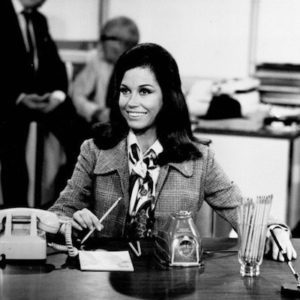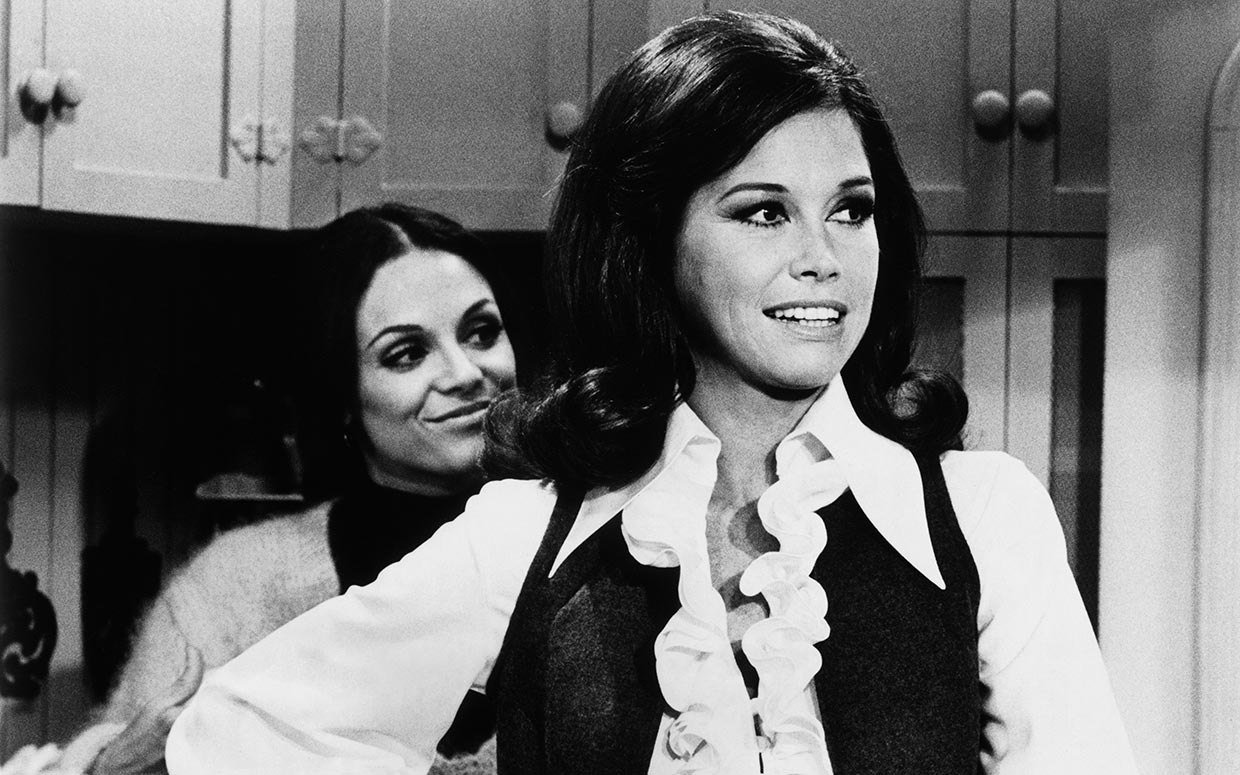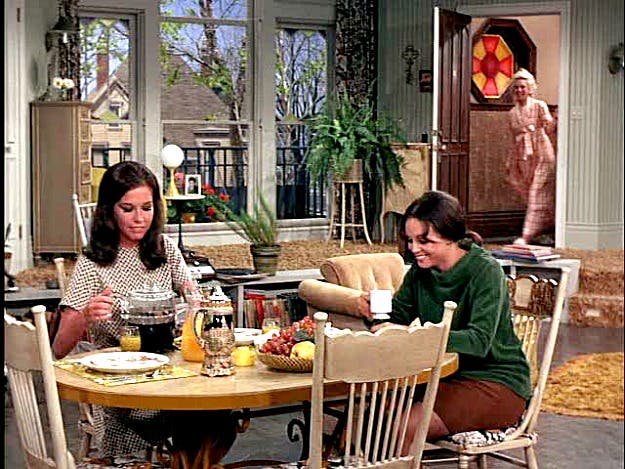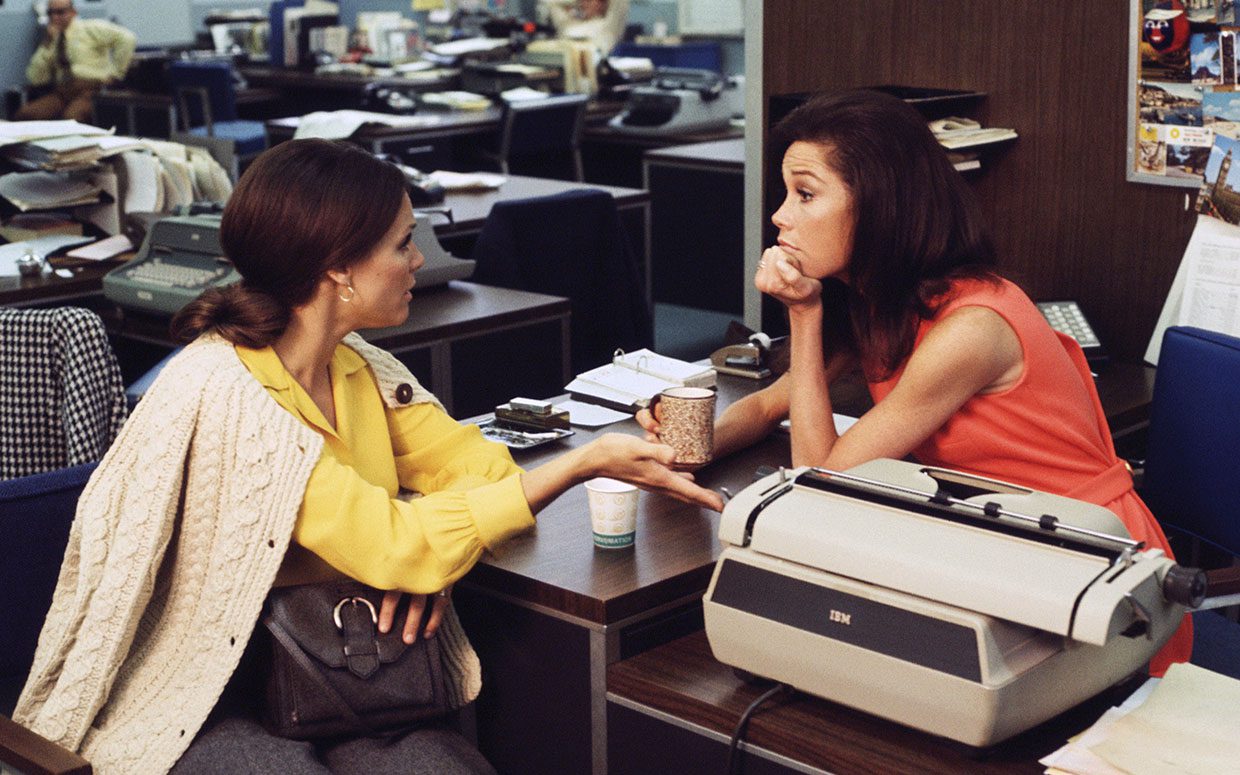
In the early months when I was first separated from my husband, I came home from work in the evenings and watched reruns of The Mary Tyler Moore Show and Rhoda. The separation had not been my idea, nor had I seen it coming. I was shell-shocked, trying to absorb this devastating rupture in the life I had for so long known and always expected.
I had grown up watching Mary reruns, but now I returned to the sitcom as a kind of instruction manual, a guide into the new life I was entering. I needed to understand what it meant to be single in my thirties. On the show, which debuted on CBS in 1970, Mary Richards moves to Minneapolis after the breakup of a long-term relationship, which had been originally scripted as a divorce. The series is actually full of stalled marriages and divorces: Mary watches friends and co-workers weather separations, affairs, and divorce. Her boss, Lou Grant (Edward Asner), separates from his wife twice over the course of the series before getting divorced during the fourth season. Her best friend, Rhoda Morgenstern (Valerie Harper), who is single throughout her run on The Mary Tyler Moore Show, later becomes the eponymous character on a spin-off series that charts her own marriage and divorce. The Mary Tyler Moore Show starts with the end of a romantic relationship and takes as its premise that in its aftermath, a new life can be built.
The opening credits of the first season depict Mary gleefully leaving her old life behind: toasted by friends at a goodbye party and then driving along the highway, following signs for Minneapolis, while the theme song croons, “How will you make it on your own? This world is awfully big, and, girl, this time you’re all alone. But it’s time you started living.” As the credits conclude, a shot of Mary’s apartment building—a Victorian house dotted with newly fallen snow—reveals the cozy outcome of all that upheaval and change, the first way our heroine will, as the song triumphantly implores, start living.
In the very first scene of the series, Mary’s friend Phyllis throws open the door to the empty apartment and flicks on the lights. “Well, Mary, what do you think?” she asks, one hand on her hip and the other confidently holding the door handle. Mary steps into the apartment, wearing a shearling coat and tall cream-colored boots. “Oh, wow,” she says, stepping down the two stairs that divide the entryway from the rest of the apartment. She looks around in smiling awe. The apartment is stunning, a testament to a small-scale version of seventies bohemian chic. The far wall is ornamented with floor-to-ceiling windows, clearly original to the house’s Victorian architecture, and the upper level near the doorway has shag carpeting in a light beige-brown.
This first episode of The Mary Tyler Moore Show premiered the year my mother moved to New York and took an apartment on the Upper West Side. She’d started a job as a flight attendant for Pan Am right out of college, flying from JFK airport to dozens of countries across the globe. On the inside, her apartment wasn’t all that different from Mary’s or Rhoda’s: small, intimate, and bohemian. My mother brought a Moroccan ottoman and Peruvian textiles back from her work trips to decorate the space. She lived with two friends, both of whom had their own professional lives. Together the three of them co-created a modern feminist identity right alongside Mary and Rhoda. They watched The Mary Tyler Moore Show in the evenings, when they happened to find themselves at home between flights and dinner parties and the demands of their jobs. They marveled at this television mirroring of the real-world lives they daily improvised and invented.
My mother wasn’t the first woman in our family affected by Mary’s cultural pioneering. Nine years earlier, in 1961, Moore wore a pair of toreador pants on national television on The Dick Van Dyke Show, and my grandmother, who until then had only worn skirts and dresses, appeared for a dinner party in her own brand-new pair of toreador pants. For two decades, Mary Tyler Moore offered a subtle shifting in women’s public identities—small, yet seismic expansions of the ways in which they could imagine themselves. It is striking (and a bit revealing) that, forty years later, the most helpful model I found for being single was a TV show from the 70s.
Mary Tyler Moore and Rhoda became my teachers in part because they carried a familial history, having influenced two generations of women in my family, but I was also drawn to them because I recognized its aesthetic traces of my own childhood: the colors and patterns that feature so prominently in the series’ later years lingered in the furniture and clothing that marked my own earliest memories.
In the months after my husband moved away, I realized that so many of my memories were part of the life we had shared together. So many aspects of my experience were now tied up in the pain and heartbreak of my ending marriage. Just as divorce involves a material reckoning as furniture and kitchen utensils get divided, it also demands an emotional sorting. Even in the early days after he left, I sought out the experiences and memories that belonged only to me: trips I had taken with friends, photos from my childhood, the people I had known and loved before and beyond him. The Mary Tyler Moore Show and Rhoda had ties to my own distinct life story; I had watched them in reruns as a teenager, before my husband stepped into my life. These shows, which I had liked well enough when I was young, became potent in a way I had not previously understood. They carried messages from a familiar past, rendered visible only now, when my life had left me in a place where I suddenly needed to receive them.
“I’m going to tell you why Mary needs this apartment,” Phyllis says to Rhoda on that iconic first episode. “A beautiful romance just blew up in her face… That’s why she’s here.”
In the worlds of Mary Richards and Rhoda Morgenstern, a life is centered around friendship and career: Mary is a television news producer and Rhoda a store window designer and later an entrepreneur. They talk about their careers over breakfast in Mary’s apartment. In one episode, Rhoda walks in still brushing her hair and prepping for work. Over scrambled eggs, they debrief a documentary Mary produced that had aired on television the night before. In another episode, Rhoda arrives at Mary’s apartment in the morning and finds her still in her work clothes from the previous day, having stayed up all night worrying over which sportscaster candidate to hire for her news show.
“Boy, Mary, you know something? You got a real Ms. job,” Rhoda quips in another episode. “What do you mean?” Mary asks, to which her friend replies, “This is the kind of job Gloria Steinem wants you to have.”
There’s a behind-the-scenes irony in this snippet of dialogue. Steinem criticized Moore’s feminism as insufficient; she didn’t like that Mary Richards was the only character in the newsroom to call her boss Mr. Grant, when all of Mary’s male co-workers called him Lou. Steinem’s criticisms are just, but they also belie the show’s revolutionary depictions of professional investment and friendship. Fifteen years before the Bechdel test first appeared in Alison Bechdel’s comic strip, calling for female characters to talk about something other than men, The Mary Tyler Moore Show passed it with flying colors. Work is integrated into Mary and Rhoda’s conversations right alongside their dating and social lives. They pursue careers they love, worry over them, take risks, and talk about it—a recurring motif woven into the intimate patterns of their friendship.
During the first summer months after my husband announced that he planned to divorce me, I told no one about what had happened except my mother and best friend, both of whom lived four hours and three states away. Nobody in my day-to-day life knew what was happening. Separation created an isolation not only from my partner, but from those I saw everyday. In its second episode, Lou Grant separates from his wife, Edie, and conceals the rift from his friends and co-workers. Mary, a relatively new professional colleague, invites him and Edie to her place for dinner, and we watch as Lou dodges her repeated dinner invitations with increasing and visceral discomfort. At the time, it felt all too familiar. I spent months stealthily reconfiguring couples’ invitations into girls’ outings and otherwise evading friends. Once I went for happy hour drinks with a new co-worker, only to have her suggest at the end of the evening that we get together with our husbands the next time. Even with a new acquaintance, this inclusion of significant others is a reflexive gesture, a part of the progression of friendship.
Without the full emotional resources of my friends, I found little in those early days of that offered comfort. I could not stand to sit still or to be at home, where the pain was often overwhelming. Throughout the summer months, I ran late at night at the local high school track and swam dozens of laps in the pool after work. After I discovered the Mary Tyler Moore and Rhoda reruns on a local television station, I started watching them regularly when I got home. I was grateful for weekdays, when I could throw myself into my work, at an arts job I had started only a couple of months before my husband left me.
“I am ready for a little more responsibility,” Mary tells Lou in Season 4. “Something challenging, something difficult.” At my new job, I found myself volunteering for extra projects: sitting in on grant reviews and networking at gallery openings that were outside the purview of my role. The job became my lifeline. It gave me a small sphere of comfort and competence, daily projects I could take on and see through to completion. A future that had nothing to do with my personal past.
On the night the local network broadcast the rerun of Rhoda’s wedding, I had stayed late at work in order to attend a grant committee meeting. I pulled into the parking space in front of my condo in a rare moment of distraction, thinking still about the committee discussion I had just been a part of. It was, perhaps, the first moment since my husband left when I got home without feeling the full force of his absence.
I had seen Rhoda before, so I knew the narrative arc of the marriage. The spin-off series starts as Rhoda meets and dates Joe Gerard (David Groh), and then marries him partway through the first season. I knew that the marriage would last only for a couple brief years, and that its unraveling in Season 3 would be as compelling as their initial courtship. Yet, rewatching it again as my own marriage ended, it held a sort of anthropological interest. The knowledge of their coming divorce made watching the first few seasons even more riveting: I watched Rhoda and Joe reach for a more modern marriage, for a more equal and bohemian partnership. I beheld at once the power and currency of their partnering and the knowledge that it would not work out. This dual awareness admitted the possibility that a marriage could be deep and purposeful and well-intentioned and still, despite all of it, end.
The night of my grant committee meeting at work, I made it home and turned on the television just as Rhoda prepares for her mad-dash from Manhattan to the Bronx in her wedding dress. Phyllis has forgotten to pick Rhoda up and drive her to her wedding, and with no luck hailing a cab, Rhoda runs across the city, hopping on and off the subway in a full-length gown and veil. The shot is unforgettable: she steps out from the awning outside her apartment, dress skirt gathered in her hands, ready to run through the streets.
It was just at that moment that I heard the surprising sound of my husband descending our staircase. He had come over that night, unannounced, apparently to talk to me. When I pulled up to my condo that evening, his car had been parked outside next to mine, and when I turned on the TV to catch the Rhoda episode, he had been here in our house waiting for me to come home. Somehow, I hadn’t noticed.
But instead of starting a conversation, he rushed from the house. He must have told me something about where he was going, because, stunned still, I eventually gathered the presence of mind to walk across the street to the grocery store parking lot, where I found him in his car, talking on the phone with his father. Eventually, we both wound up back in the kitchen of the home we had bought together, the home we so recently shared.
He had come over to tell me he was dating other women.
I already knew.
One day a few weeks earlier, I had forced myself to stand next to the kitchen table and open the growing piles of mail. I turned the stack of envelopes upside down, and started methodically slicing through their flaps, glancing at them and sorting them into stacks. This chore represented a small, but precious, reclaiming of order. Partway through the project, I inadvertently opened a credit card bill that belonged to my husband; I hadn’t looked at the front of the envelope, so it took me a minute of blinking to process what I was looking at. Hundreds of dollars of dates: he had been to movie theaters and minor-league baseball games and several of our favorite restaurants, places I had found and introduced us to years ago. And there was the sheer amount of money that he had spent on his dating life in the weeks since he left: six hundred dollars from our still-joint finances. I pushed the bill back in the envelope.
My mother had given me a simple piece of advice in the days immediately after he left, when the pain made it difficult to believe my body would continue to breathe. Don’t flame the pain, she said.
I held onto that.
When I pushed that credit card bill back in the envelope, I also did a split-second reframe. I would not be troubled by it. It was good that he was dating. His clearly voracious (and costly!) dating life would help him work this separation out of his system, would squelch whatever curiosities or what-ifs that had compelled him to leave. The sooner he started dating, the better. The sooner our separation would end; the sooner he would come back.
As the long days of summer peaked and arced into August, I consciously taught myself how to be at home for short periods of time. How to offer myself respites of peace in the midst of pain. Mary Tyler Moore and Rhoda offered me an hour of solace, and though I would not have described it this way then, when I was working so diligently to bring my husband back home, it also offered hope and optimism. It allowed me to begin to imagine another future, another path forward into a life that, while not what I expected, would still feel like mine.
At one point during the third season of The Mary Tyler Moore Show, Mary reconnects with an old boyfriend, who becomes serious about her very quickly. When he asks her to marry him, she replies, “Dan, I know that what I’m about to say may sound a little, you know, negative, but, uh, no,” and he laughs.
“We know that you said that because you’re scared to make a commitment,” he tells her.
“No,” she answers. “I admit that back when I thought that someday I had to get married it would have scared me, but now that I know that I don’t have to get married, it doesn’t scare me.”
By the time October arrived, I started to reach out to friends and family members. For several weeks, I took each of my closest friends out to brunch and dinner to tell them what had happened. “I have something to tell you,” I said, before breaking the news. These conversations over restaurant tables felt like a dozen stereotypical sitcom breakups, except that I was announcing a breakup from myself, over and over again.
Over the course of the fall, I started to learn to be at home by myself. In a long relationship, patterns develop, divisions in daily life. One person becomes the one who plays the household music. One person becomes the one who waters plants or takes out the trash. I found as autumn arrived that I did not have a clear understanding of what music I liked. What did I want my house to sound like when only I was at home? When Lou and Edie Grant finally separate for good, during the fourth season of the show, Edie tells Lou, “I want to learn more about the rest of me—not just the part that’s your wife. I want to know what I’d do with a whole week to myself. What I’m like when I’m scared and depressed and I don’t have you to make it all right again. I may hate it, and I may screw it up. But I want to have time to get to know [myself].” That autumn, I started picking out core truths: song by song, one glass of wine and pot of soup and phone call to a friend at a time, I started to name the simple ingredients of my life that were integral to my identity without him.
In the wake of Lou’s separation from Edie, he finds that he wants a female friend he can go out and do things with, a date without being a romantic date fully. Someone who allows him to be in the world, who adds companionship and dynamism to this in-between period of time. Mary fixes him up with Rhoda, and for nearly a whole episode, they have fun together. “We go out. We have fun. We have a few laughs. She likes hockey. She likes an occasional beer,” Lou says. Rhoda explains to Mary, “You know, he’s such a relief from the guys I’ve been going out with. There’s no pressure. There’s no unspoken questions. I mean, he’s a man and I’m a woman, but we can go out, have a great time. No big problem and no questions.” They go to a dinner for department heads at the television station where Lou and Mary work; they go to hockey games and have dinner at Rhoda’s apartment. Eventually it fizzles out, but the purpose of their dates was never permanence: it was the in-the-moment joy and richness that this low-key friendship brings. When my best friend bought me a three-month membership with an online dating site, I filled out my profile with Lou and Rhoda in mind.
In many ways, these shows from the 1970s wound up being my twenty-first century guides because they offered an authenticity that was original (sometimes shockingly so) in its time and remains unique in film and television even today. Characters like Mary and Rhoda hadn’t been turned into stereotypes of single women in their thirties or career women or divorcees. They couldn’t be: they were the first. And fortunately they were thoughtfully written and lovingly acted characters: Moore had been through a divorce herself by the time she and her second husband used their MTM production company to create the series, and she hired a writing and production team that included a significant number of women. The barrier-breaking television producer Charlotte Brown wrote and later executive produced many of the Rhoda episodes that steered Rhoda through her divorce and her single life afterwards. These were shows acted and written and produced with women at the fore: women who knew what friendship and professional ambition looked like. Popular culture now is inundated by depictions of single and divorced women in their thirties who often become self-caricatures. Mary and Rhoda’s characters are warm and funny and strong and vulnerable; they are inimitably human.
Mary Tyler Moore died this January, at age eighty, of cardiopulmonary arrest brought on by complications from several other medical conditions. Her own life was marked by pioneering creative vision and by immense personal hardship. She left behind a body of films and television programs that suggest with deft frankness that life can be both more difficult and richer than pop culture usually depicts. Outside of the nuclear confines of marriage and family, Mary Richards’s experience—like indeed, so many of our own—is vibrantly defined by the multifaceted gradations of collegiality and friendship. Life might bring unexpected setbacks, Moore’s series posits, but those setbacks create space for opportunities we ourselves could not have planned. The experiences Moore imagined for women back in the 1970s were—literally and figuratively—elsewhere unscripted. Exactly forty years after the final episode of her eponymous series aired, Moore’s show still calls on us to be open to the many ways women can pave paths forward for themselves in the world.
In late autumn, the year of my divorce, when I started to lay claim again to my own identity, I was no longer home to catch Mary Tyler Moore and Rhoda every evening. I started meeting friends for dinner, venturing out on dates occasionally, and going to concerts and gallery openings solo. The Mary Tyler Moore and Rhoda lineup on my local television station got cancelled by the time the winter started. But by then I didn’t need them as much anymore. I’d gotten my own apartment downtown. I might just make it after all.
***
Image credits: feature image, image 1, image 2, image 3, image 4, image 5.









